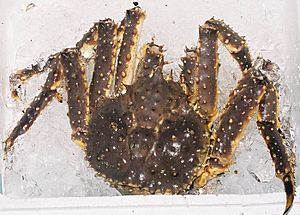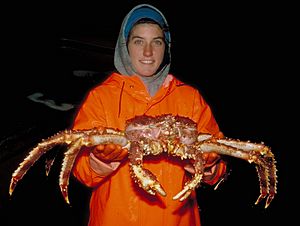Red king crab facts for kids
Quick facts for kids Red king crab |
|
|---|---|
 |
|
| Scientific classification |
The red king crab is a super cool creature of the sea! It's also known as the Kamchatka crab or Alaskan king crab. This amazing crab lives in the cold waters of the northern Pacific Ocean, like the Bering Sea and the Gulf of Alaska. It was also brought to the Barents Sea. These crabs can grow really big, with legs that can stretch up to 1.8 m (5.9 ft) wide! People really like to catch these crabs for food.
Contents
About the Red King Crab
The red king crab is the biggest type of king crab. Its main body shell, called a carapace, can be up to 28 cm (11 in) wide. Its legs can spread out to 1.8 m (5.9 ft), and it can weigh up to 12.7 kg (28 lb)! Male crabs usually grow larger than females.
Today, most red king crabs caught are smaller. The average male crab caught in the Bering Sea weighs about 2.9 kg (6.4 lb). This crab gets its name from the bright red color it turns when it's cooked. When it's alive, it's actually more of a dark red or burgundy color.
Where Red King Crabs Live
Red king crabs originally live in the Bering Sea and the northern Pacific Ocean. You can find them near the Kamchatka Peninsula and the waters around Alaska. In the 1960s, the Soviet Union brought some of these crabs to the Barents Sea near Murmansk Fjord. They wanted to create a new and valuable fishing opportunity in Europe.
These crabs can live in water temperatures from −1.8 to 12.8 °C (28.8–55.0 °F). They usually prefer temperatures between 3.2 to 5.5 °C (37.8–41.9 °F). Younger crabs like even colder water, below 6 °C (43 °F).
The depth where a crab lives depends on its age. Baby crabs, called larvae, stay in shallow waters. This is where they can find plenty of food and stay safe. After about two years, the crabs move to depths of 20–50 m (66–164 ft). Here, they form large groups called "podding," where hundreds of crabs gather closely together.
Adult crabs usually live deeper, often more than 200 meters down. They prefer sandy and muddy areas on the seafloor. In winter or early spring, they move to shallower waters to mate. But for most of their lives, they stay in the deep waters where they feed.
Fishing for Red King Crabs
The red king crab is the most popular and expensive type of king crab to catch. It's often caught in the Bering Sea and Norton Sound, Alaska. Catching these crabs is very difficult, but they are highly desired for eating.
The number of red king crabs in their native waters has been going down. Scientists aren't sure why, but they have some ideas. It could be due to too much fishing, warmer ocean temperatures, or more fish eating the crabs. Even with fishing rules set by the United States in the 1980s and 2000s, the crab population has continued to shrink.
Red King Crabs in Europe
In the 1960s, the Soviet Union moved red king crabs from the North Pacific to the Murmansk Fjord. The crabs didn't survive being moved over land. So, a new group was flown in. These crabs survived, were released, and started to breed and spread in the wild.
The first red king crab was found in Norway in 1977. In the Barents Sea, these crabs are considered an invasive species. This means they are not native to the area and are spreading very quickly. Their growing numbers worry local environmentalists and fishermen. The crabs eat almost everything on the seabed, which can make the ocean floor seem like a "desert."
Since the 1960s, they have spread west along the Norwegian coast and even reached Svalbard. Scientists believe they are moving about 50 km (31 mi) further south each year. In Norway, some people even call them "Stalin's crabs."
By the mid-1990s, the king crabs reached North Cape. The Norwegian Institute of Marine Research found that by 2010-2013, they had reached Sørøya and were breeding there. A few have even been caught as far south as Tromsø. There is a concern about what might happen if they reach the areas where cod fish lay their eggs, like off Lofoten.
In 2009, a red king crab was caught off Skogsvåg near Bergen in southern Norway. A natural enemy of the red king crab, the North Pacific giant octopus, does not live in European waters. This means the crabs have fewer predators there.
A fisherman in Honningsvåg complained that the king crabs' claws were ruining fishing nets and lines. Despite these concerns, the red king crab is protected by agreements between Norway and Russia. These agreements help manage the crab population in the Barents Sea and set limits on how many can be caught. West of the North Cape, Norway manages its own crab population. For some Norwegian fishermen, the king crab is a good source of income.
Red King Crab Life Cycle
Mature female red king crabs need to stay in warmer water (around 4 °C). This helps their eggs get ready for hatching. Male red king crabs stay in colder water (around 1.5 °C) to save energy. In spring (May), female crabs move to shallow coastal areas to molt (shed their old shell) and lay their eggs. Males join them in the shallow water before molting too.
In the summer (mid-June to mid-November), these crabs spend their time in fairly deep water. When the water layers mix in the fall, the crabs move back to medium depths. They stay there until the female crabs release the eggs that were fertilized earlier.
The red king crab can handle a wide range of temperatures, but temperature affects how fast they grow. They grow and molt slowly when the water is below 8 °C. Around 12 °C, they molt much faster.
Red king crabs are good at adapting to changes in how salty the water is. They can keep their body working well and continue to feed. Young crabs are a bit better at handling low salt levels than adult crabs.
Even small changes in the water's pH level (making it more acidic) can greatly affect red king crabs. They grow slower in more acidic water (pH 7.8 instead of 8.0). If they stay in acidic water for too long, they can even die. This is because the acid makes it hard for their bodies to stay balanced.
How Red King Crabs Breathe
The red king crab has five sets of gills that it uses to breathe. These gills are inside a special space called the branchial chamber, which is under its main body shell (carapace). The carapace is like a protective cover that hangs over the crab's legs. This cover creates two branchial chambers, each holding gills.
The surface of the gills is covered in a thin, skin-like layer that lets gases pass through. This allows the crab to take in oxygen from the water. To move water over its gills, the crab uses a special leg-like part called the scaphognathite. It moves this part back and forth to create a current. Water is pulled in from behind the walking legs and then pushed out near the crab's mouth. The crab also has tiny hairs to filter the water before it enters the gill chambers, keeping out dirt.
Each gill has a main stem with many small, thin parts called filaments. These filaments have tiny blood vessels. Blood flows into these filaments, picks up oxygen, and then flows back to the crab's heart. Red king crabs breathe by moving water in one direction over their gills. Water enters near their claws, flows over the gills, and then exits near their head.
How Red King Crabs Move Blood
Red king crabs have an open circulatory system. This means their blood-like fluid, called hemolymph, flows somewhat freely among their body tissues. It's then collected and sent back to the heart. The heart is located in a special chamber. The hemolymph enters the heart through small openings.
Seven main tubes, called arteries, carry the hemolymph from the heart to different parts of the body. These arteries branch out into smaller ones, which eventually release the hemolymph into open spaces in the body. The hemolymph then collects in a large space and is sent to the gills to pick up oxygen. After getting oxygen, it returns to the heart chamber.
The crab's heart beats because of special nerve cells. These nerve cells send signals that make the heart muscles contract. This is how the heart pumps the hemolymph around the body.
Red king crab hemolymph contains cells similar to white blood cells. It also has a special protein called hemocyanin. Hemocyanin is like the crab's version of hemoglobin (what makes our blood red). But instead of iron, hemocyanin uses copper atoms to carry oxygen. When hemocyanin has oxygen, it turns blue!
Images for kids
See also
 In Spanish: Cangrejo rojo gigante para niños
In Spanish: Cangrejo rojo gigante para niños




